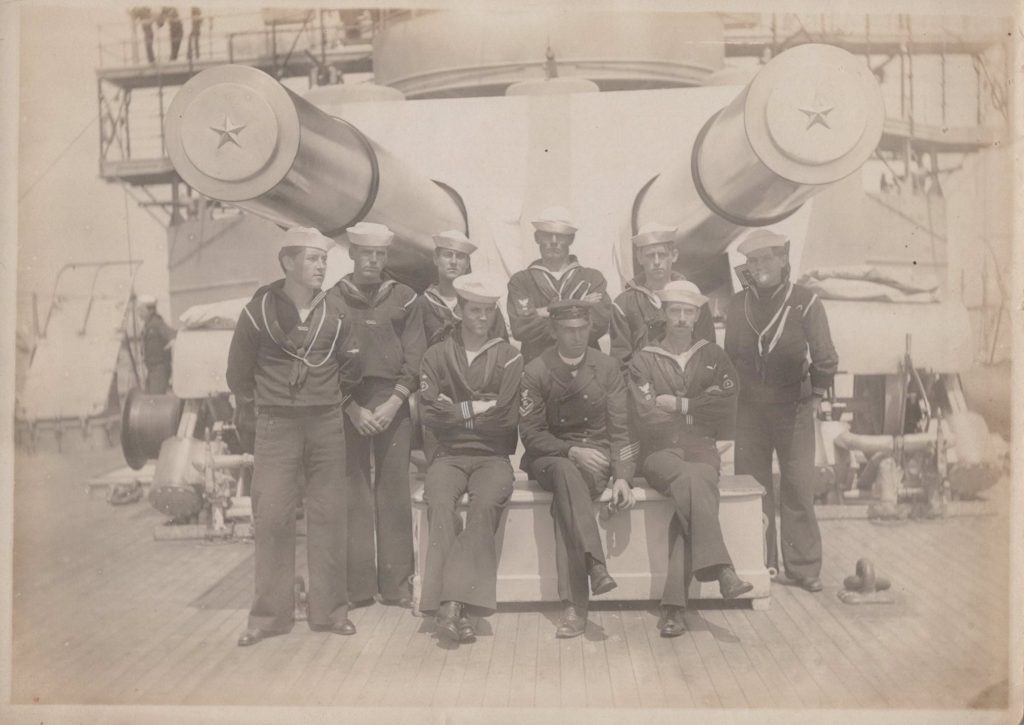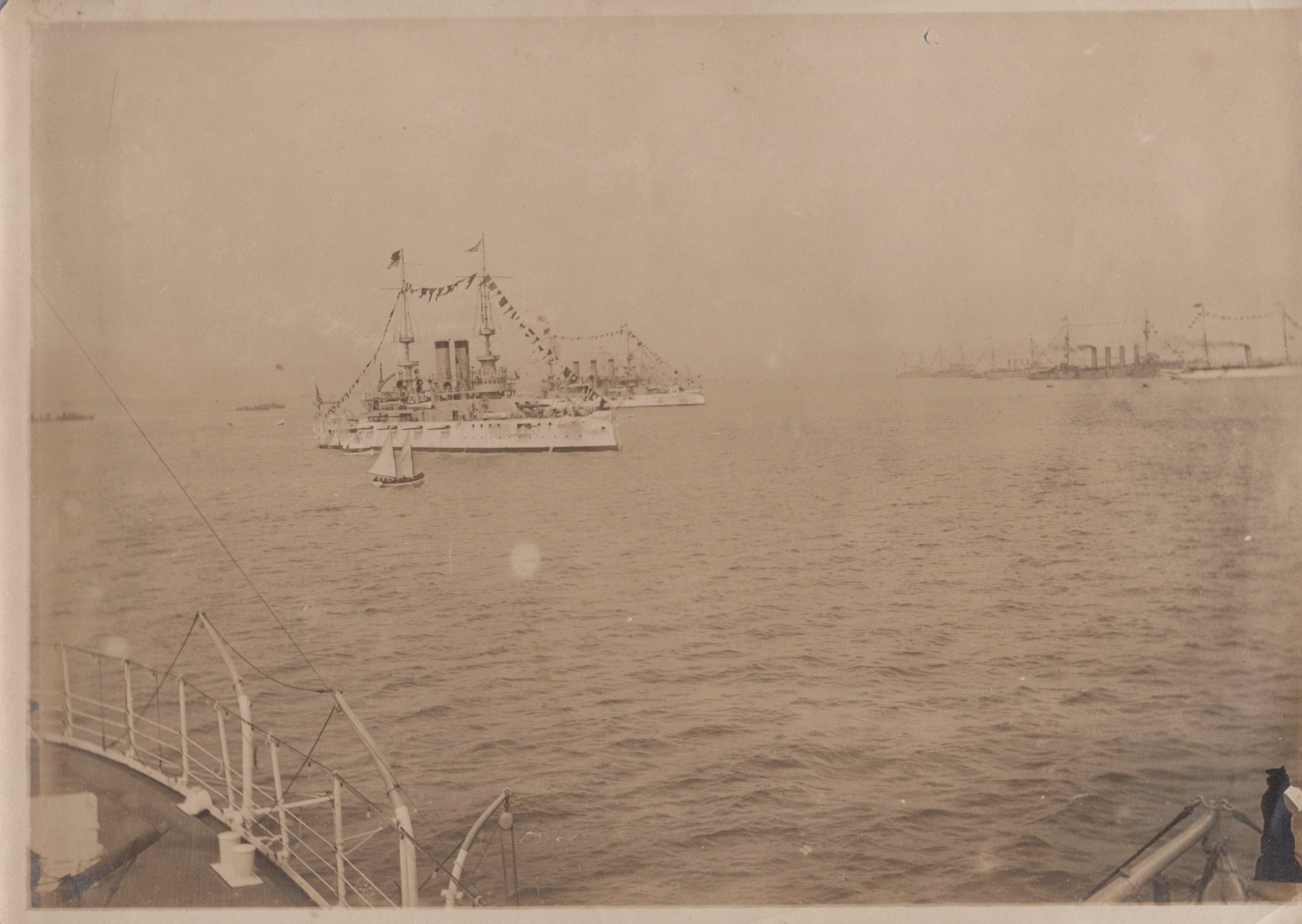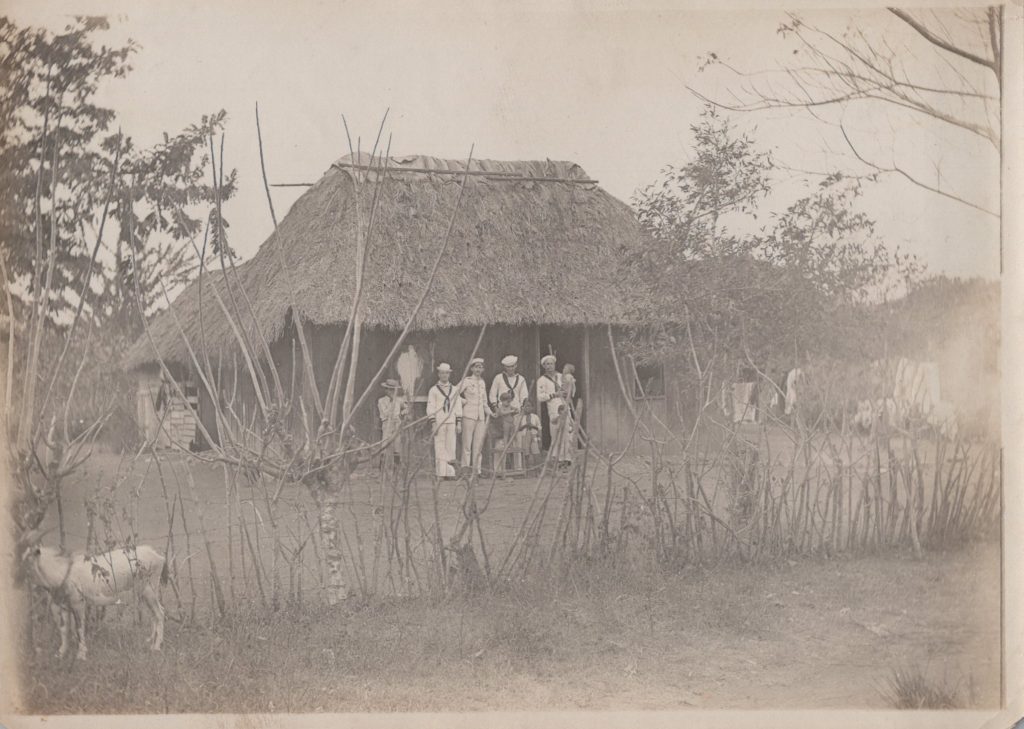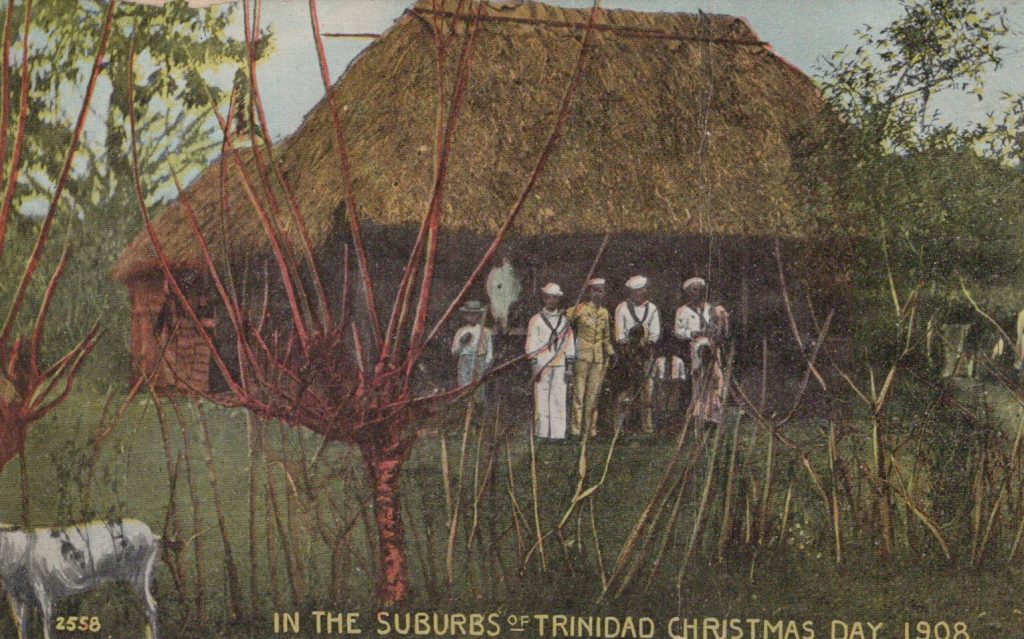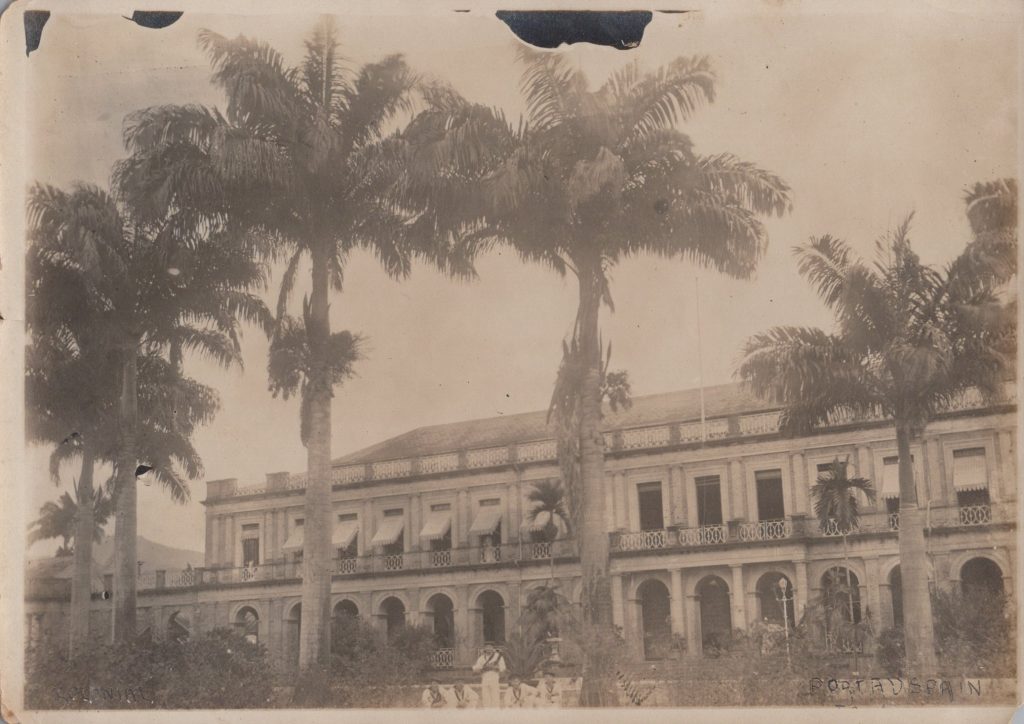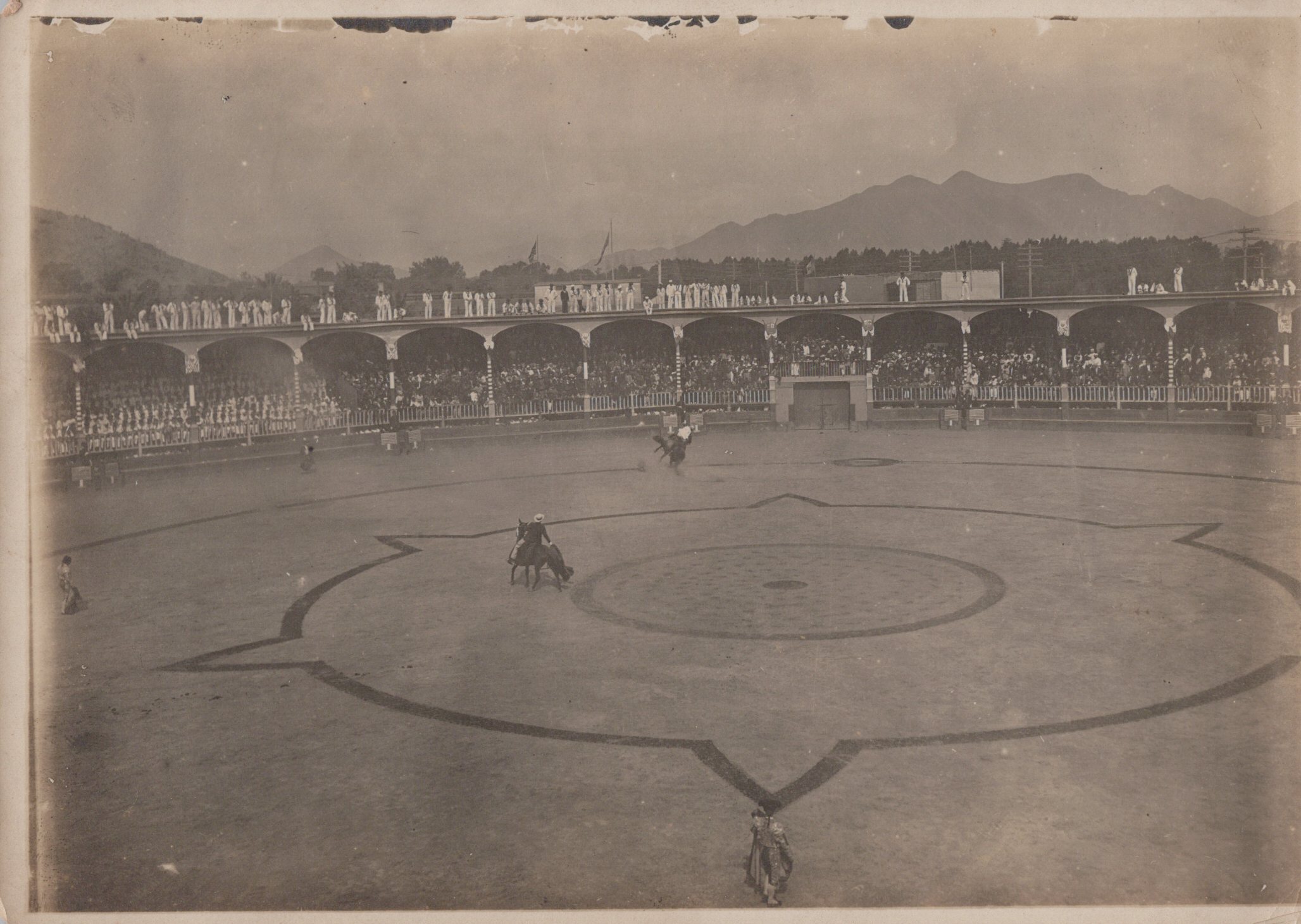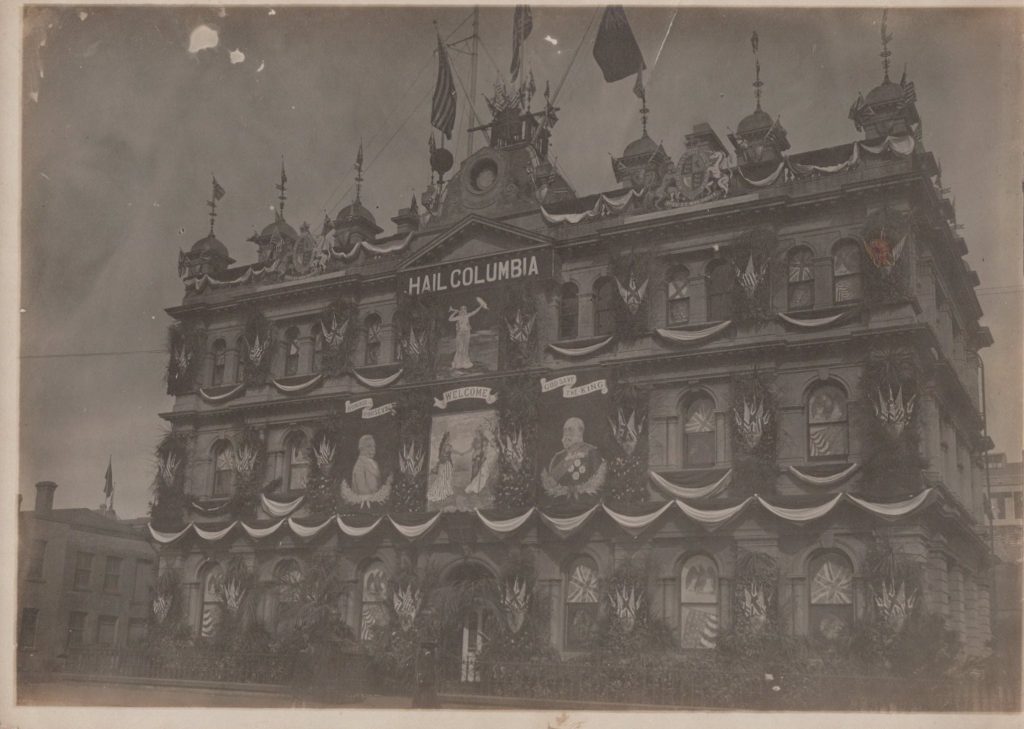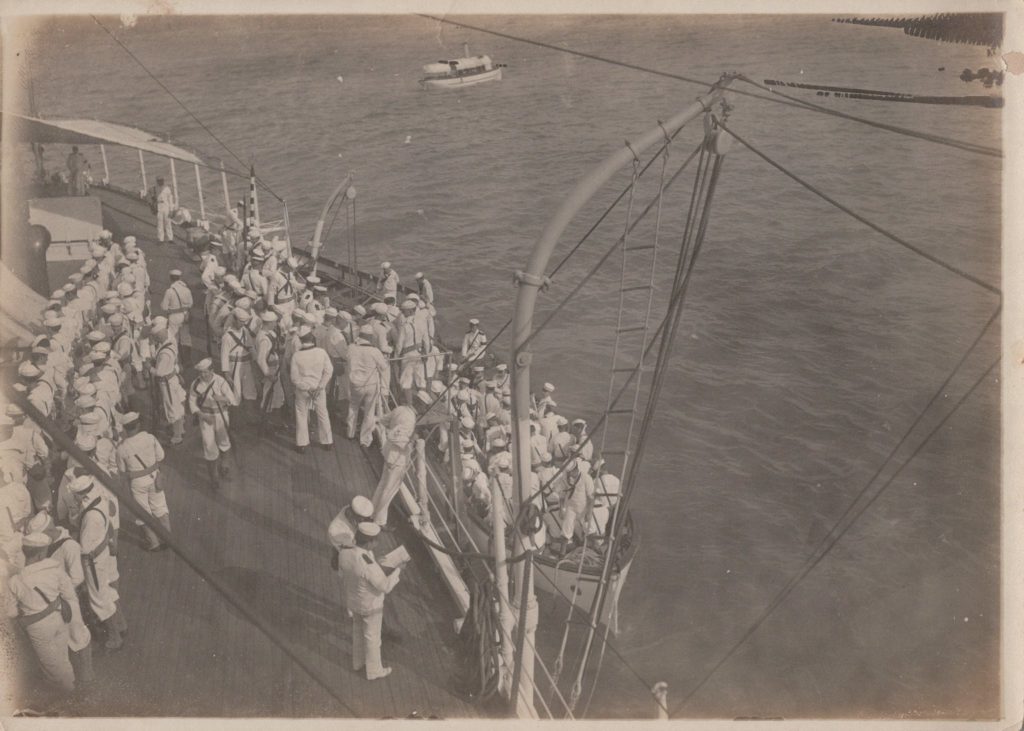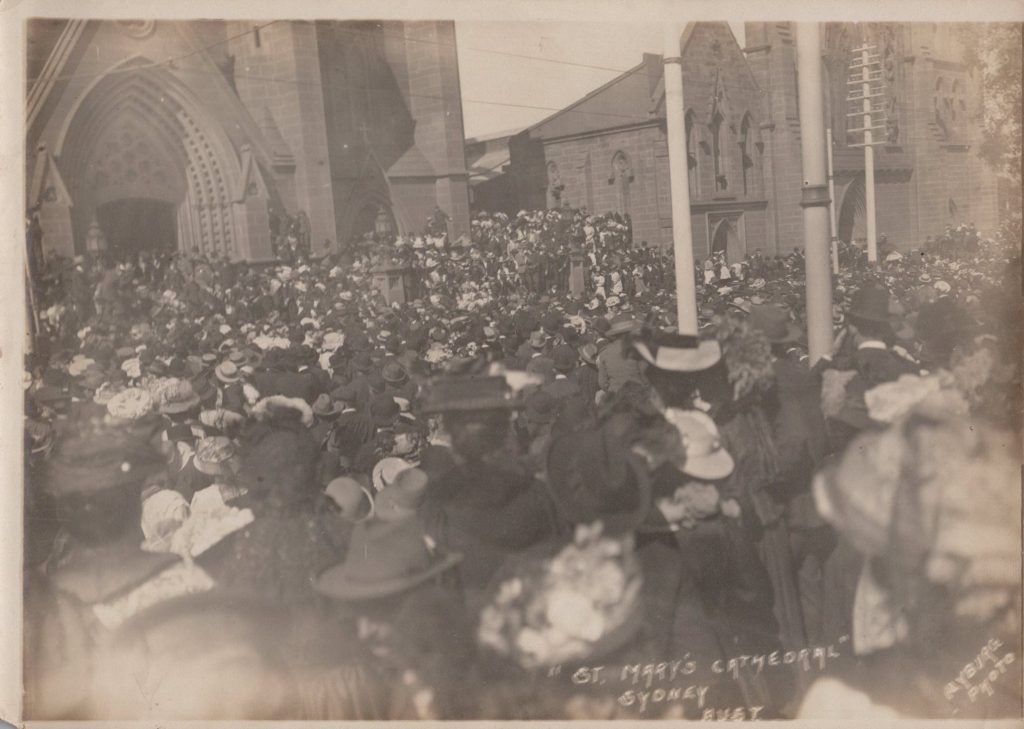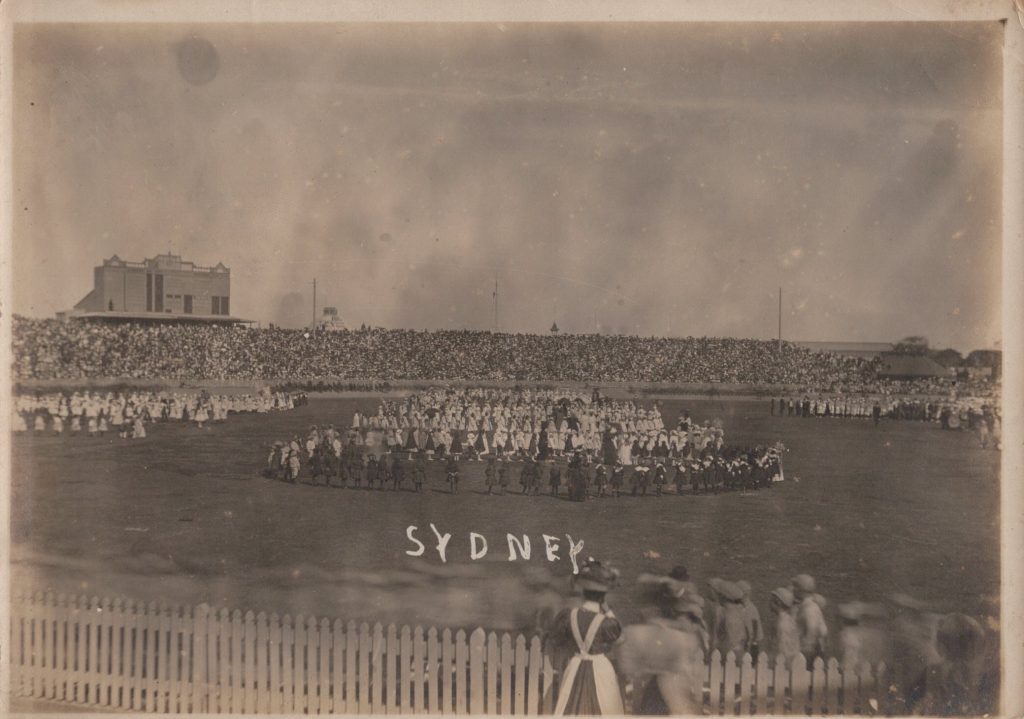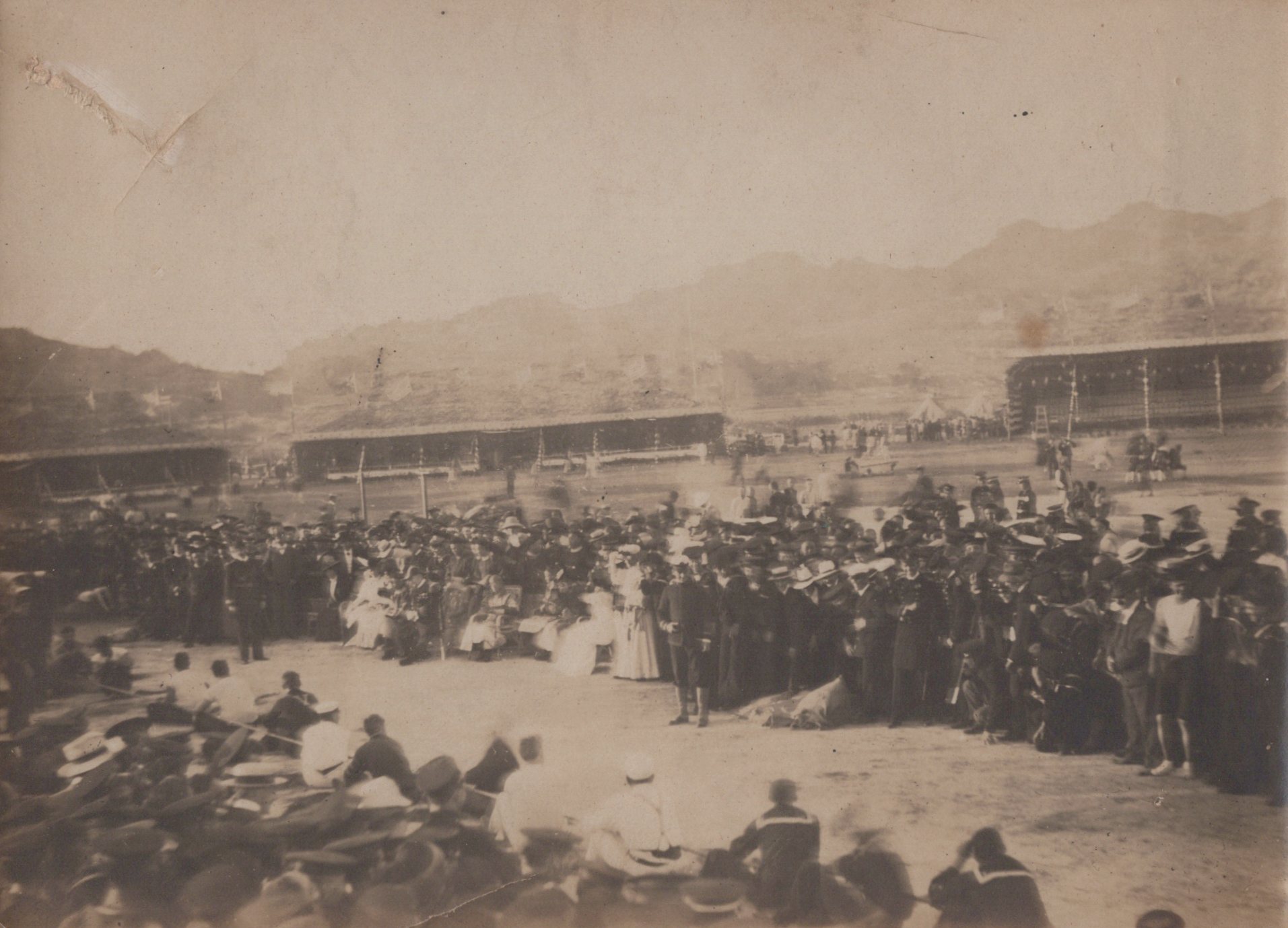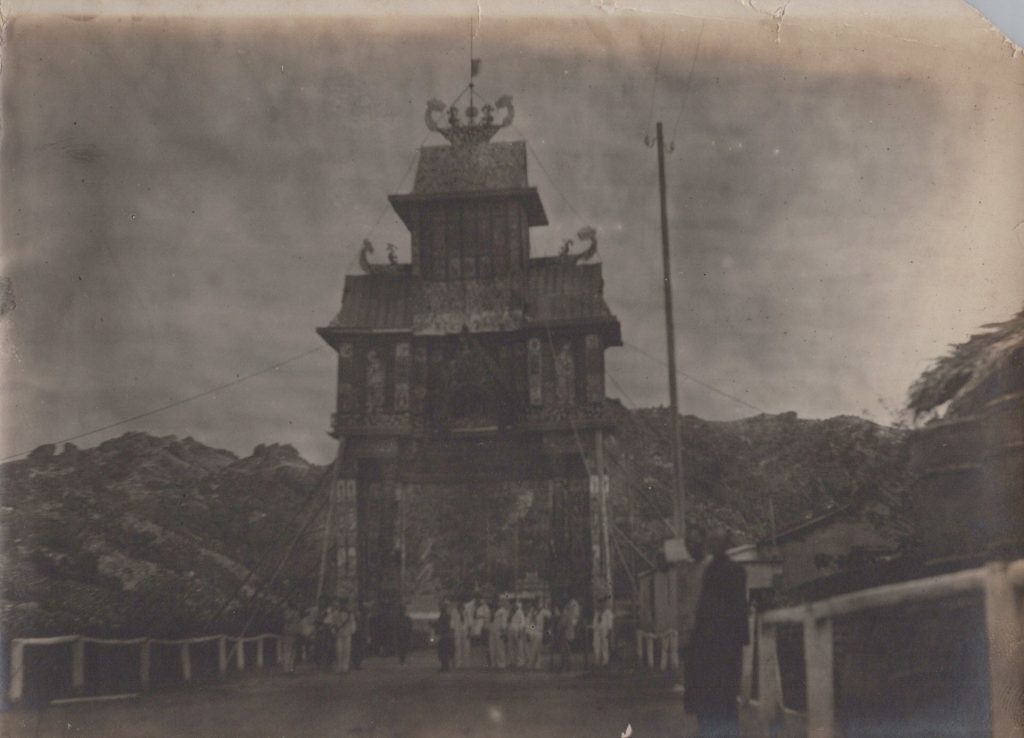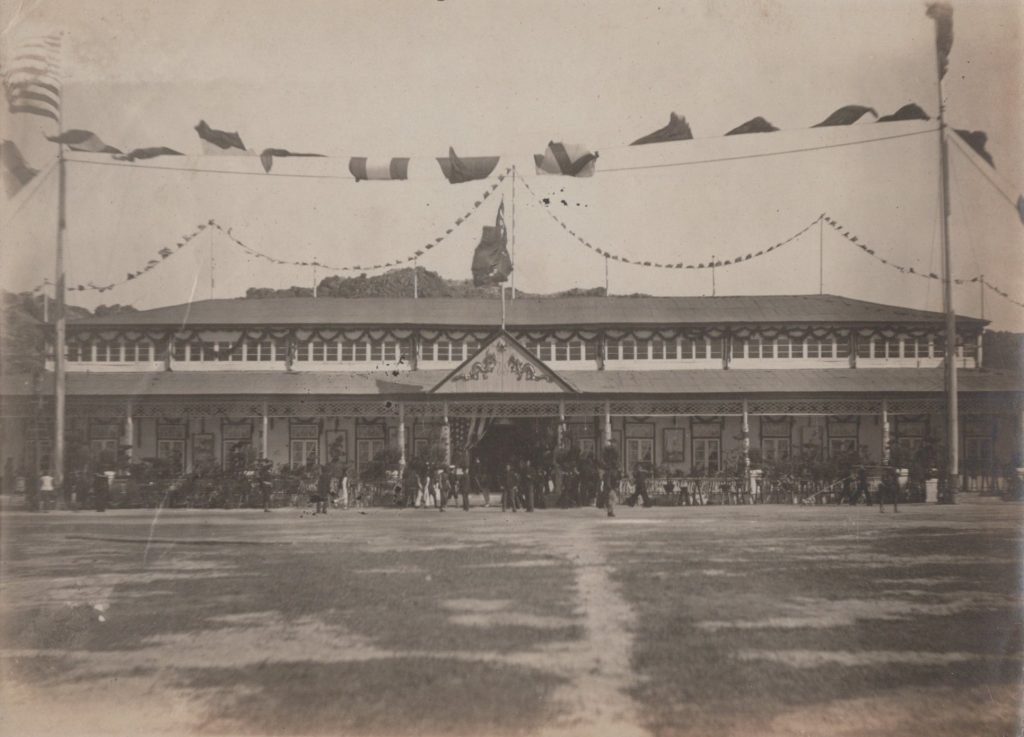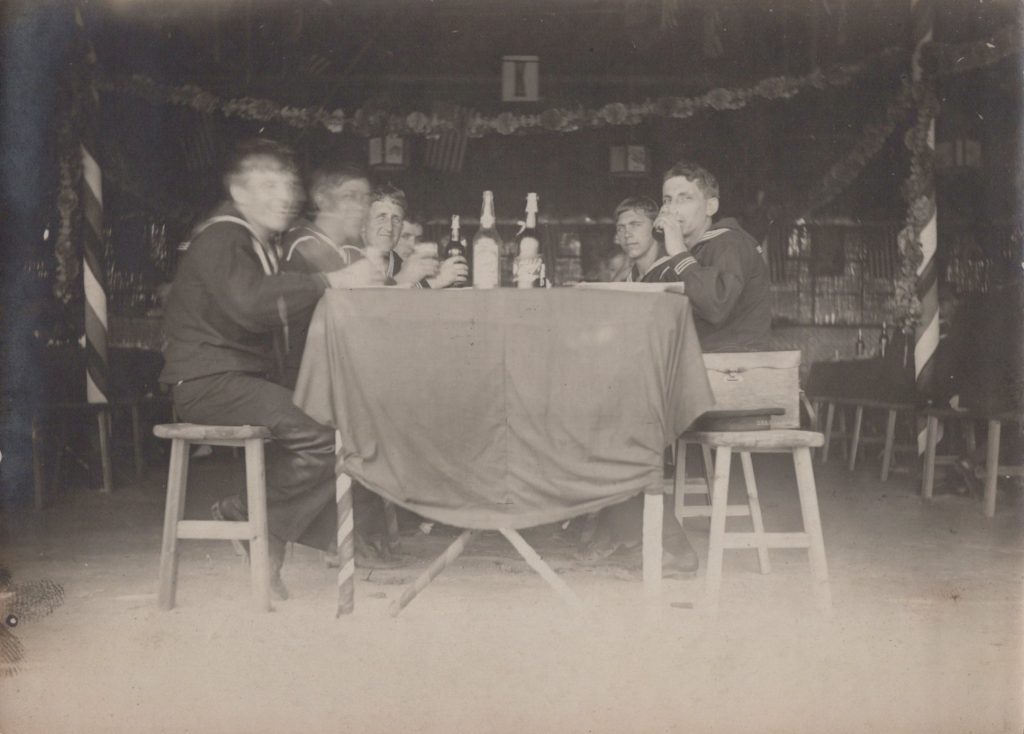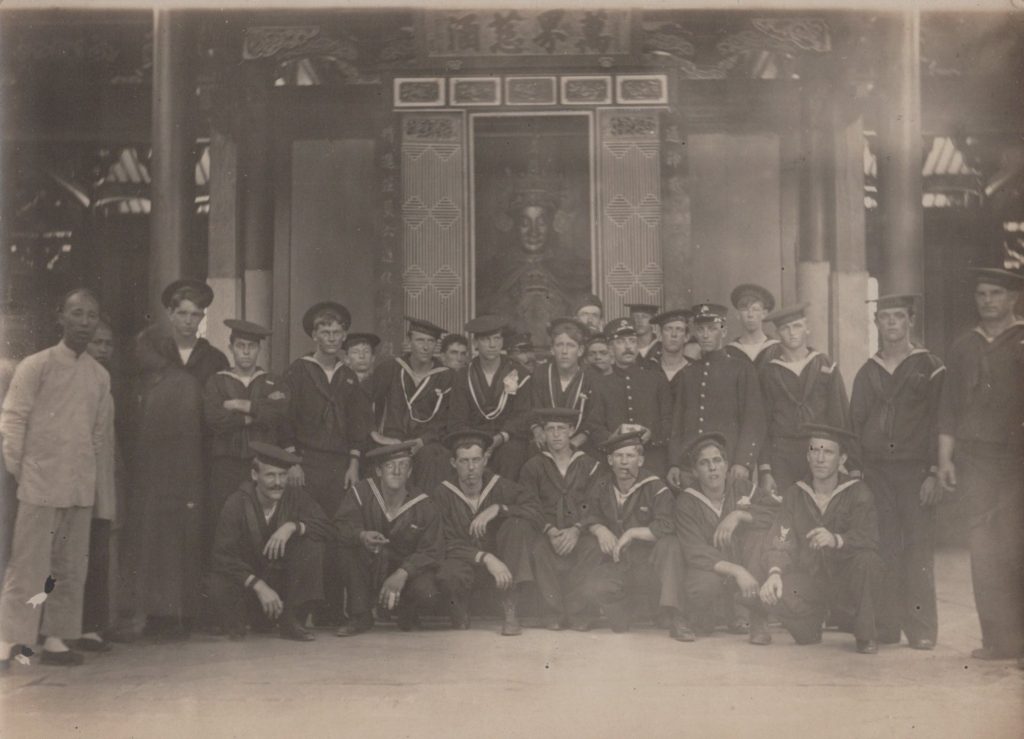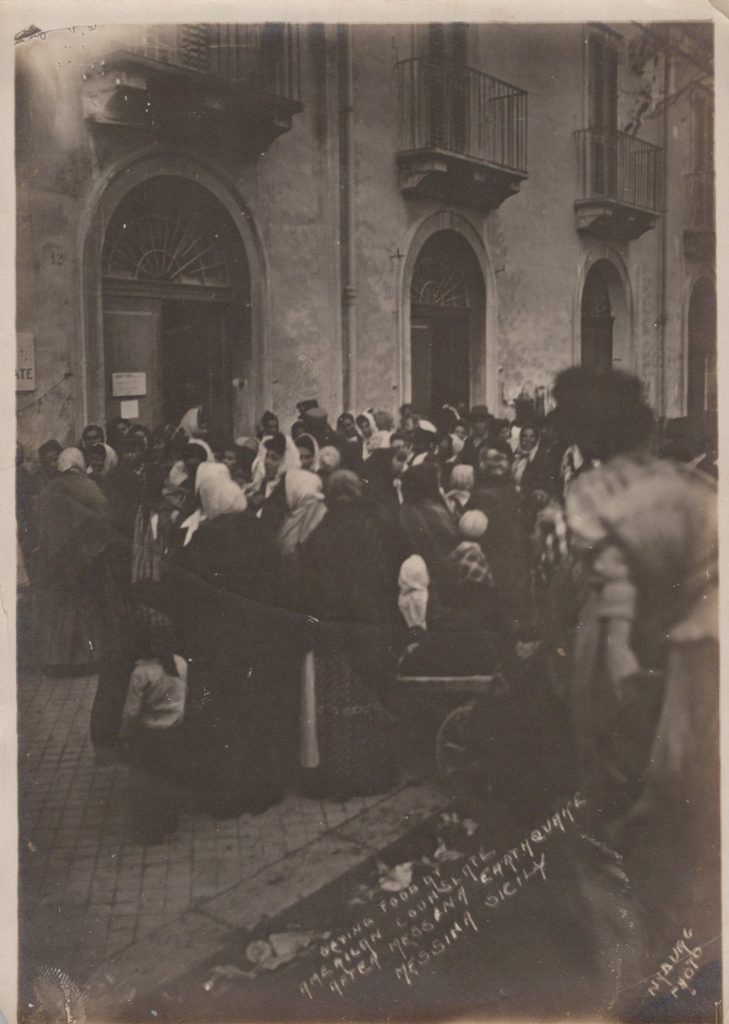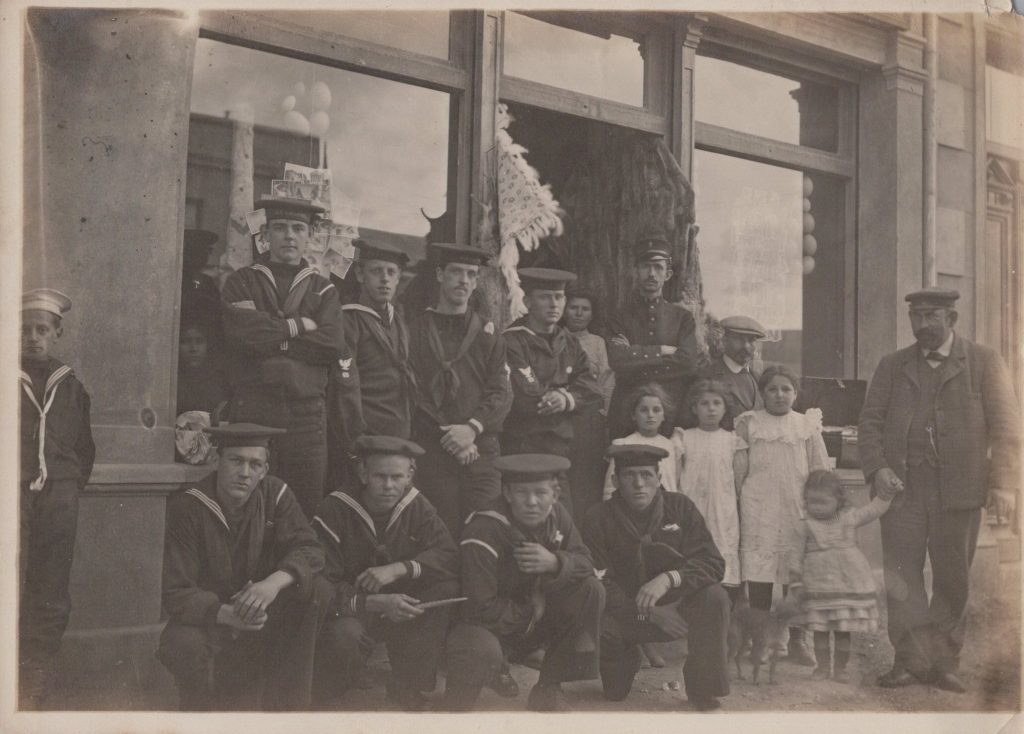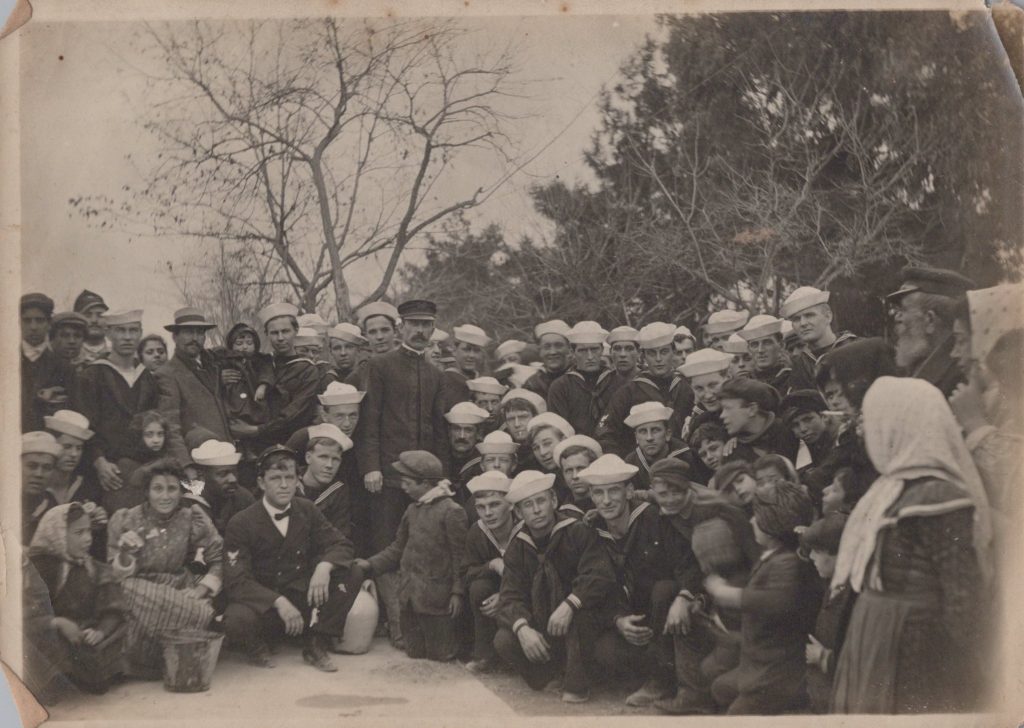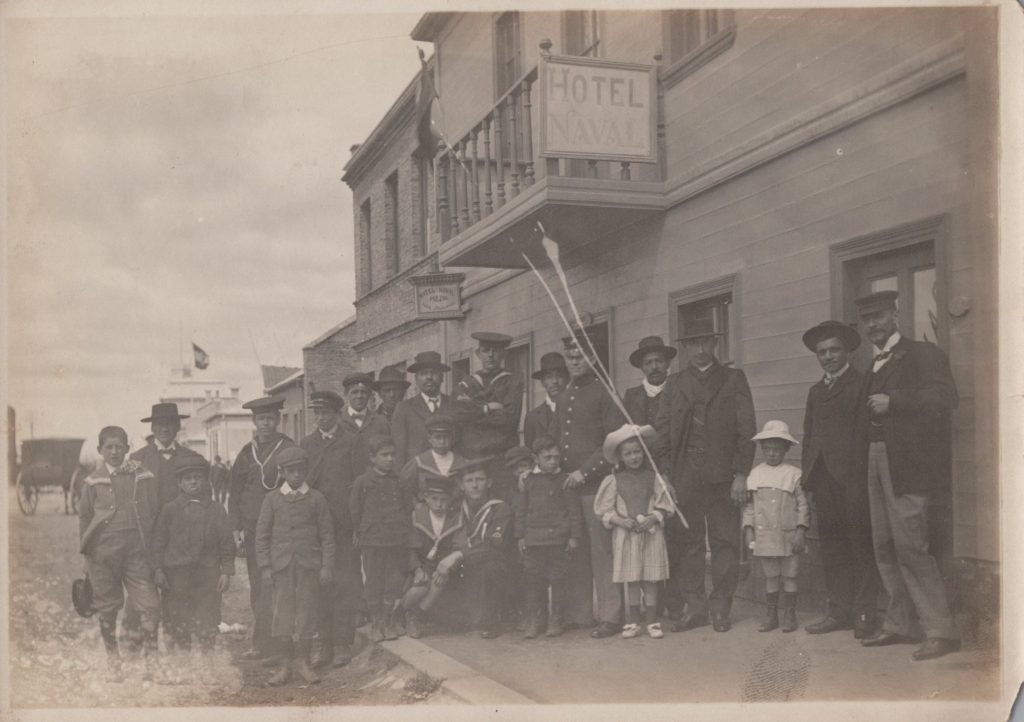Apologies, but no results were found for the requested archive. Perhaps searching will help find a related post.
When I acquired the first few photographs of this collection I did not know much about the photograher. I knew that the person had participated in the entire cruise. I knew that they had been in second squadron and had visited Amoy, China. With the next batch I found they had visited Messina, Italy. There is only one ship that could have been in both places, the USS Illinois. Illinois was in the Second Squadron to visit Amoy, and was with Connecticut to visit Messina. Connecticut did not visit Amoy. In the next batch of card was a photograph of "Victory" the breach of a gun mount with a written label on the back "aft turret gun 13 inch". This confirmed it was a photographer from the Illinois having 13" gun mounts. In the last batch were two photographs signed "D. Nyberg Photo" and "Nyberg Photo" confirming the photographer.
As can be seen in this photograph, the sailors are mustered with their Chief Petty Officer in their dress blue uniforms and hats on a clean forecastle. This would indicate that is was a professional photographer who was doing group shots. The sailors in this photograph seem dis-interested in the process and certainly seem ready for it to be over. I certainly do not think that anyone in this photograph expected to get a copy to send home.
It would be my guess that this was a "mandatory" photograph that each division on the ship was scheduled to show up and get completed for some reason. Possibly a journalist who got permission from the command to complete a set of group photographs.
hampton roads time of the jamestown exposition
This is a great photograph of the ships dressed to receive visitors. The ship closest in the photograph is an Illinois Class battleship. If Seaman Nyberg was photographing from his ship, that would have made it the Wisconsin or Alabama. The Alabama participated at the Jamestown Exposition so this is most like her if this is well before the cruise. Also in the background can be seen the Presidential Yacht Mayflower and a vessel with four stacks. This is most likely the USS West Virginia who also participated in the events of the Jamestown Exposition after completing target practice in Cuba. She left Cuba on April 10, 1907 and participated in the Naval Review conducted by President Roosevelt between the 7th and 13th of June. It is most likely the period this photograph was taken.
port of spain, trinidad
I have placed Seaman Nyberg with the photographers of my collection because his photographs seemed to involve a function of his job. His subjects clearly are staged and the compositions well planned. His camera produced 5 x 7 prints that were not sold during the cruise. After the cruise it appears that at least one photograph, and possibly more, were sold to H. H. Stratton. Below is his photograph and a card by H. H. Stratton labeled, "In the Suburbs of Trinidad Chirstmas Day 1908." Clearly a cropped image from the same negative. As Seaman Nyberg took photographs in Messina, Italy, I believe these H. H. Stratton cards are most likely from his negatives.
colonial hospital, port of spain
The opening of the Colonial hospital took place on September 1, 1858 on St. Ann's Road, now Charlotte Street. The staff consisted of 68 officials, a surgeon, three assistant surgeons, three supernumeraries, and nurses. The original capacity for the hospital was 400 beds. It was considered the finest in the West Indies and was quickly over-taxed with patience. By 1882 admission to the hospital was restricted to persons needing surgery, or who had diseases that needed constant medical services. In 1899 it was fitted out with it's first x-ray machine.
Today the building continues to serve the community as the Port of Spain General Hospital providing obstetric and gynecological care, outpatient medical care, surgical specialties such as orthopedics and plastic surgery, therapeutic support and emergency care. It also serves as a teaching hospital to medical students from the University of the West Indies.
This photograph shows a group of five sailors posed out front. The sailor standing in the center appears to be holding something that is wrapped around his shoulder. In the left corner is the word "colonial" written on the negative.
rio de janeiro
The photograph at left shows a dining room of a restaurant with balconies and guest rooms above. Sailors can be seen dining at a table and turning for the photograph. Hotel guest above pose as well. To the right can be seen the owner or waiter standing by a large sideboy where pitchers and teapots stand ready. My best guess for this photograph is the Grande Hotel situated on the Largo da Lapa, a community in downtown Rio that sailors frequented. The Grande Hotel was a fine hotel that appears to be large enough to have a central area shown in this photograph.
The photograph at right is titled on the back, "Dinner in Rio de Janeiro. In the photograph is a long table arranged under a covered structure with American and Brazilian flags hanging from the trusses. The table seems to include approximately 30 sailors who are dining with fruits, bread, and plates of food. It is possible that this is one of the planned events of the YMCA that coordinated lunches and dinners for the crews while they were ashore. There was a market near the fleet landing that might have had covered structures like this used to sell merchandise and that they were used for this occasion of the fleet's visit.
the bullfight in callao, peru
honolulu, hawaii
At left is a "Bird's Eye View" looking down into Waikiki and Diamond from up in the Pali Pass over the island. Looking closely you can see the battleships at anchor and at piers in an area that is all beachfront now or part of the downtown property at Fort Derussy and the current Navy Hotel Hale Koa. At right, sailors preparing to go ashore to participate in the parade. On deck sailors can be seen with their pieces and ammo belts with bayonets and canteens.
auckland, new zealand
At left the Harbor Boards Office Building decorated with bunting, flags and ;pictures of the friendship between two nations. "Hail Columbia" with palm branches and clusters of flags. The was designed by David Ross and was constructed as brick and mortar with a slate roof, completed in 1883. It was designed as the headquarters for the Union Steam Ship Company and functioned as that until 1921. Afterwards it became the headquarters for the National Mortgage and Agency Company. In 1940 it underwent a major transformation. Most of the building's original exterior decoration was destroyed for a quasi-Art Deco style and after a new change in ownership it continued functioning. As best I can tell the building is still standing and seeking a place on the New Zealand Historic Trust.
sydney and melbourne, australia
Below are four cards from Sydney. The first showing the crowds outside St. Mary's Cathedral after Sunday services. This is another card that is signed by Nyberg in the lower right corner. In second photograph is the Statue to Captain James Cook who explored charted and claimed the east coast of Australia for the British Empire in 1770. The public dedication took place in 1879. The third card shows the Kings Monument, erected to commemorate the Consort of Queen Victoria, Prince Albert. Prince Albert was the husband of Queen Victoria and died at an early age of 42 causing Queen Victoria to morn the death for the rest of her life. The statue was cast in Nuremberg and erected in 1866 five years after his death. The last card shows the review held in Centennial Park which was the largest military display to be held up until that time. Over 250,000 people watched the events of that day.
The below photograph shows the Melbourne Town Hall with decoration for the visit of the American Fleet. The clock tower show the time of day to be 2:45 as a group of men to the right observe the process of getting a photograph of the building. The building was started in 1842 and has served the City for many of it events over the years including a visit from the Beatles in 1964. Over the years it has seem many additions and improvements included the clock tower, "Prince Alfred's Tower" which was started in 1874.
photographs from amoy china
This group of cards are among the best photographs I have seen from the fleet's visit to Amoy. Very few photographs exist of the pavilion and the activities of the sailors during the visit. Below is a scene showing a tug-of-war match on the grounds of the pavilion. In the center can be seen a standing officer presiding over the outcome. In the background can be seen the stalls where sailor could purchase souvenirs and the hills surrounding the site.
The photographs below show two of the structures that were built on short notice for the American fleet's visit to Amoy. The photograph at left show one of the entrance gates with a group of sailors posing before going through to the path to the pavilion. It appears there were several of these gates starting at the fleet landing where the sailor disembarked. The photograph at right shows the main pavilion hall with a group of sailors and marines standing out in front of the entrance. This is the building were the event dinners and occasions were held during the fleet visit.
Below left is a group of sailors enjoying a beer in one of the covered areas around the pavilion grounds. At right is a group of sailors and marines visiting a Buddhist temple with a guide standing to the left. This might have been nearby at the local town or within the western community town that was located in Amoy.
The earthquake response to messina italy
The Messina earthquake was an international disaster that the United States tried to support by sending ships with the available supplies they had from the fleet of battleships. The USS Connecticut, Illinois and the Culgoa (AF-3) were tasked to render assistance. Unfortunately, Italy express that it did not need this assistance and the continued on with their schedule. Photographs of sailors ashore during the brief visit as scarce. Seaman Nyberg provides more images to the fleet's visit that any other source from the cruise.
In the photographs below, people stand in line to get food at the American Consulate. Part of the mission of the Fleet was to recover the bodies of the American Consulate in the ruins of the building they were living. Food from the ships might have been brought to this site, given it was American property, to be distributed to people in the community. The photograph at right is a group of sailors posing on the street with a family. A father is seen with his FOUR daughters. To the left can be seen an escort from the Italian Navy. The tall sailor to the left in the back row wears a hat talley from the USS Culgoa.
In the group photographs below sailors from one of the battleships are posed with a group of civilians. In the center appears to be a Chief Warrant Officer and down low to the left a chief petty officer that were probably leading the working party of men. At right is the same group from the photo above. This time they are in front of the Hotel Naval, certainly a popular destination for sailor of the Mediterranean.

